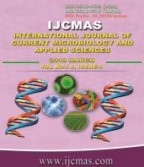


 National Academy of Agricultural Sciences (NAAS)
National Academy of Agricultural Sciences (NAAS)

|
PRINT ISSN : 2319-7692
Online ISSN : 2319-7706 Issues : 12 per year Publisher : Excellent Publishers Email : editorijcmas@gmail.com / submit@ijcmas.com Editor-in-chief: Dr.M.Prakash Index Copernicus ICV 2018: 95.39 NAAS RATING 2020: 5.38 |
A study was carried out to evaluate the microbial quality of goat carcasses at Dallma island slaughterhouse in Alzafraa District, UAE, during June 2017. A total of 284 swab samples were collected from 40 carcasses for identification of the isolates and bacterial total viable counts (TVCs). Cotton swab samples were also collected from knives and hands of workers used in the slaughter process. The study found that predominant bacterial isolates at Dallma were E.coli and Staphylococcus aureus and these were revealed very low values before and after treatment of operational points also at worker's hands and their knives were low, but Salmonella spp. was not detected. The mean total viable count (TVCs) post skinning, post evisceration and post washing at neck site was 2.26 ± 0.81, 2.48± 0.81 and 2.74± 0.66 log CFU/cm2 before the treatment, whereas after treatment was 1.60 ± 0.60, 1.65 ± 0.58 and 1.33 ± 0.58 log CFU/cm2 with statistically significant difference (P<0.05). In brisket site, TVCs before treatment of the carcasses were 2.24 ± 0.64, 2.62± 0.57 and 3.01±0.52 logl0 CFU/cm2 but after the treatment of the samples were 1.67 ± 0.94, 1.87 ± 0.74 and 1.68 ±0.81 CFU/cm2, with statistically significant difference (P<0.05).TVCs of the samples from the rump site samples before treatment at operational points, revealed mean 2.54± 0.49, 2.56±0.84 and 2.37±0.63 log10 CFU/cm2 and after treatment were, 1.73 ± 0.81, 1.87 ±0.74 and 1.55±0.62 logl0 CFU/cm2 respectively (P<0.05). In shoulder site, TVC in the three points of operation before treatment were 1.37±0.62, 2.75±0.84 and 2.73±0.66 logl0CFU/cm2, whereas after treatment 1.40 ± 0.73, 1.73 ±0.45 and 1.61 ±0.69 logloCFU/cm2 with statistically significant. TVC in knives after skinning and evisceration before treatment samples were 3.23±0.66 and 3.00±0.48 log CFU/cm2 while after treatment were 1.18 ± 0.28 and 1.30±0.47 logCFU/cm2. Also the TVC, of the hands of the workers post skinning, post evisceration and post washing were 3.15±0.37, 3.43±0.34 and 3.15±0.30 logl0 CFU/cm before treatment samples, but in treated samples were 2.54 ± 0.41, 1.64 ±0.44 and 2.68 ±0.79 logl0 CFU/cm2 respectively. The decontamination processes are important to eliminate the sources of contamination and that by application of food safety methods such as HACCP and an appropriate training for personnel.
 |
 |
 |
 |
 |